Nosferatu Blu-ray Movie 
Extended Cut / Blu-ray + Digital CopyUniversal Studios | 2024 | 1 Movie, 2 Cuts | 136 min | Not rated | Feb 18, 2025
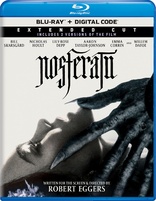
Movie rating
|
| 7.9 | / 10 |
Blu-ray rating
| Users | 0.0 | |
| Reviewer | 5.0 | |
| Overall | 5.0 |
Overview click to collapse contents
Nosferatu (2024)
A gothic tale of obsession between a haunted young woman in 19th century Germany and the ancient Transylvanian vampire who stalks her, bringing untold horror with him.
Starring: Lily-Rose Depp, Nicholas Hoult, Bill Skarsgård, Aaron Taylor-Johnson, Willem DafoeDirector: Robert Eggers
| Horror | Uncertain |
| Mystery | Uncertain |
| Drama | Uncertain |
| Fantasy | Uncertain |
Specifications click to expand contents
Video
Video codec: MPEG-4 AVC
Video resolution: 1080p
Aspect ratio: 1.66:1
Original aspect ratio: 1.66:1
Audio
English: Dolby Atmos
English: Dolby TrueHD 7.1 (48kHz, 24-bit)
French: Dolby Digital Plus 7.1
Spanish: Dolby Digital Plus 7.1
Subtitles
English SDH, French, Spanish
Discs
Blu-ray Disc
Single disc (1 BD)
Digital copy
Packaging
Slipcover in original pressing
Playback
Region A (B, C untested)
Review click to expand contents
Rating summary
| Movie | 4.5 | |
| Video | 4.5 | |
| Audio | 5.0 | |
| Extras | 4.5 | |
| Overall | 5.0 |
Nosferatu Blu-ray Movie Review
"I will be addressed as the honor of my blood demands it."
Reviewed by Justin Dekker February 18, 2025Just over 100 years ago F. W. Murnau's silent-era masterpiece 'Nosferatu' landed in movie theaters. Remaking the vampire's earliest appearance
on the silver screen, Robert Eggers' 'Nosferatu' is now on digital and arrives on 4K UHD, Blu-ray™, and DVD on February 18, 2025, from Universal!
This modern retelling stars Lily-Rose Depp ('Yoga Hosers') as new bride Emma Hutter, and Nicholas Hoult ('The Great') as her husband Thomas,
alongside Willem Dafoe, Emma Corrin, and Bill Skarsgård as the monstrous Count Orlok. Atmospheric and frightening, it succeeds in being worthy
of
its namesake. Fans will be pleased to note that the new release features a terrific 1080p transfer, a lively Dolby Atmos track, and a short but
meaty
list of on-disc supplemental features. A slipcover, and Digital Code redeemable through Movies Anywhere are included in this Blu-ray release.
Director Robert Eggers immediately unsettles and destabilizes audiences as the film opens with Lily-Rose Depp's as-yet-unnamed character at the
tail-end of her youth in the
midst of a frantic plea that she delivers as something that is prayer and lustful summoning in equal measure. The viewer is unsure if her utterances
are directed at diety or demon, though it seems she is casting it into the ether for the benefit and attention of whomever or whatever may be
listening. Soon, she is in a trance-like state quickly confirming that she has connected with something malevolent, something wishing to claim her
for its own. Some years later in Germany in 1838, her Emma is a young bride. Her husband Thomas (Nicholas Hoult) we learn, isn't the
most competent, ambitious, or lauded employee, but his employer, Herr Knock has selected him for a weeks-long assignment that will see him
traveling to a castle in the Carpathian Alps to help facilitate the aged and eccentric Count Orlok's move to Germany. Hesitant at first, he quickly
understands that this unusual and somewhat undesirable task will secure his position with the firm and his future. He can't resist. Emma fears her
recent nightmares are a dark portent, but Thomas vows to her that he will be safe and will write to her each day. After a journey filled with strange
people and stranger happenings, Thomas's horror won't truly begin to grow until he reaches Count Orlok's castle and begins his work as the fiend
takes an unusual interest in Thomas' new wife. Soon after, the Count arrives in Wisberg putting many of the good townsfolk, and Emma, in
particular, in jeopardy.
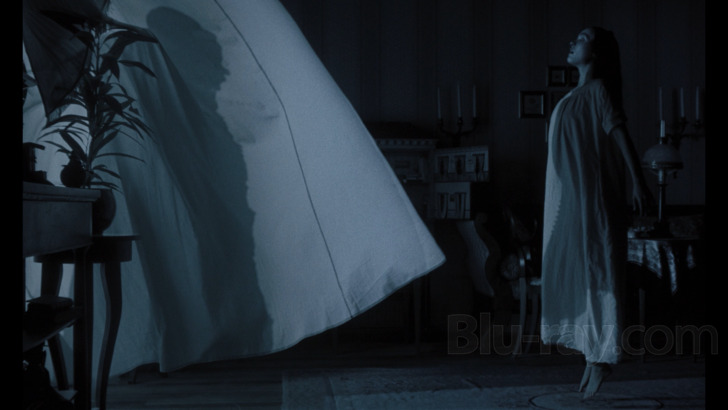
The original version of Nosferatu (1922) was born into controversy and chaos. When it arrived on movie screens, Bram Stoker's widow was rather displeased, and justifiably so. Even to the casual modern-day viewer, there are an amazing number of similarities between that film and Bram Stoker's novel from 1897, Dracula. Sensibly, she took the matter to court in an effort to protect her husband's intellectual property, contending that Murnau's film "borrowed" heavily from her husband's novel. Unsurprisingly, when the court weighed the facts, they determined that it was, despite some largely cosmetic adjustments, rather derivative of that now-vaunted text. As part of the settlement, the court ordered that all existing prints be destroyed so as to enforce the copyright and thereby ensuring Dracula's legacy. While Nosferatu (1922) was almost lost forever, luckily for film fans, while that destructive resolution was executed quite thoroughly, not every print perished. When Bram Stoker's Dracula finally fell into the public domain in 1962 some fifty years after his death, that iconic film was finally freed from its untimely grave and was able to bring new generations of moviegoers under its spell. Since that time, the character of Nosferatu has wormed his way into many pop culture corners, from becoming a punchline of sorts on SpongeBob SquarePants, to being mentioned in Type O Negative's "Black No. 1".
Stoker's book is truly foundational for all modern vampire tales and much of what we know and take as "fact" in all vampire films comes from that work and Universal's classic and authorized cinematic adaptation, Dracula (1931), and it's sequels. Other films, most notably the output from Hammer Studios, would add to that mythology. But the plagiarised Nosferatu (1922)'s impact is no less significant and some elements from that 1922 project have infected the vampire films, television, and literature that would follow in its wake. In one of the changes made to the story when crafting his film, a vampire could be destroyed by exposure to direct sunlight. This particular weakness has meant salvation for many an incarnation of Van Helsing and other horror heroes while furthering the ideology that vampires are foul creatures of the night; impure entities that can be purged from the earth by the sun's cleansing rays. No need to have a crucifix or a wooden stake handy, a protagonist could simply survive the night and simply be near a window to vanquish their foe. Just as significantly, unlike Bela Lugosi, Christopher Lee, or Frank Langella, three of the best- known actors to give life to the world's most famous bloodsucker, Nosferatu is monstrous; with an off-putting visage and claws and fangs instead of the charming and eloquent seducer portrayed by those men. No, Nosferatu is instantly repulsive, needing to remain in the shadows to escape notice, and reliant on positional power to impose his will through manipulation, intimidation, and fear. He shuns the attention and focus that numerous Draculas would use to their advantage. And why shouldn't he be repulsive on some level? After all, the vampire is one of the undead, sustained by blood and ambulatory, but definitely not alive. Not human.
Cinematically, modern instances of monstrous vampires can be found in various films, though 1998's Blade (1998) and 1996's From Dusk Till Dawn (1996) stand out as two particularly noteworthy and entertaining examples. Getting even closer to the actual look of the 1922 iteration of Nosferatu is The Master, the primary antagonist of the television series The Strain which premiered on FX in 2014. With his pale complexion, gaunt build, and pointy ears mixed with some decidedly bat-like facial features, he looks like Nosferatu's unholy offspring. While there are some key biological differences between him, his progeny, and Nosferatu, the influence of the character design seen in Max Shreck's classic portrayal is obvious. Though they would share the same name, Klaus Kinski's iteration of cinema's original vampire in Werner Herzog's Nosferatu the Vampyre (1979) strikes a balance between the 1922 incarnation and the more viciously animalistic descendants mentioned. He could pass for a human if he needed to, but he clearly isn't. Kinski would veer much closer toward a traditional Dracula when he reprised the Nosferatu role in Augusto Caminito's Nosferatu in Venice (1988) where his character's sexual appetites would rival his thirst for blood. He's still not exactly debonair, but he certainly appears to be more man than monster. In Robert Egger's film, Bill Skarsgård's Count Orlok/Nosferatu returns the character to its roots, making him, once again, a monster, and utilizing the technology of the day to push those frighting elements of the character's design further than would have been possible in the 1920s.
After the shocking opening scene, Eggers and cinematographer Jarin Blaschke work to generate a film that is rich in atmosphere. Light and shadow are used to to great effect, helping the audience to understand when they should feel some sort of normalcy and safety, and when situations are more uncertain or dangerous. Specific shots are used to not only establish locations, but also to drive a deep sense of Thomas's isolation on his journey to Orlok's castle. Near the terminus of his trip, it is well-documented that he is alone, ill-equipped, and no help of any kind will be forthcoming.
Increasing the atmosphere of dread, the people he meets along the way offer little succor or comfort. The further from Germany he ventures, the more obvious it is by virtue of how he dresses that he doesn't belong. He doesn't understand local customs and fails to grasp the significance of the locals' attitudes toward Count Orlok. Similarly, his actions demonstrate that he doesn't understand local superstitions, believing that he, though a foreigner, is wiser and therefore knows better, further removing him from any potential support or assistance and increasing, though unknown to him, the likelihood of his demise. It's not truly until he reaches the castle that he begins to ascertain that he's out of his depth. Thomas has foolishly been holding on to a notion that he has or would have control over the business dealings with the Count. Afterall, he's a young businessman from modern Germany, while the Count has been portrayed to him as elderly, infirm, and clearly living in the crumbling ruins of a castle clinging desperately to the edge of nowhere. The count almost immediately disabuses him of those beliefs, increasingly dominating him with each passing moment. Everything that should be isn't, and for everything we see in the light, it quickly becomes apparent that the more important things remain in the darkness. Dread steadily builds with few chances for the audience to find a release as the bodies mount until it finally reaches capacity. By that point, things have become so taut that a resolution of the main conflict, regardless of the outcome, is desperately welcomed.
Through it all, the performances of the lead actors play off of and feed into the sense of impending doom. Depp's Emma is disturbed from the very beginning. Even though she should be in the throes of wedded bliss from her recent nuptials, she's clearly not happy. She's pensive, and worried, and feels both unwanted by her husband and unwelcomed by others. Her visions/dreams invaded and/or controlled by Nosferatu take an increasingly visible toll on her, and when she's in the depths of the strange "possession" it's genuinely frightening. Hoult's performance is similarly on-point. Channeling his most hopelessly myopic moments from The Great he informs the viewer that Thomas is not anyone's idea of a hero. But here, he is also given numerous opportunities to demonstrate the peril that his character faces, the terror he feels for himself, and the horror he experiences over his concern for his wife. Dafoe, who has demonstrated a tendency to chew scenery with the best of them when the role or the film allows, for as outlandish as his Professor Albin Eberhart von Franz is, exercises a considerable amount of restraint in not allowing his characterization to devolve into camp. In lesser hands, his exchanges and efforts could serve as comic relief, but in Dafoe's, the Professor may mean well and possess more information on the subject than most, but his miscalculations and misfires merely serve to increase tension as they suggest that our heroes may not actually have what they need to save themselves or others from Nosferatu. While Bill Skarsgård performs his role as Count Orlok/Nosferatu excellently, it's really the actions and reactions of these key cast members (and others) who inform the audience just how frightened of Nosferatu we should be. And they abundantly demonstrate that we should be terrified.
Nosferatu Blu-ray Movie, Video Quality 
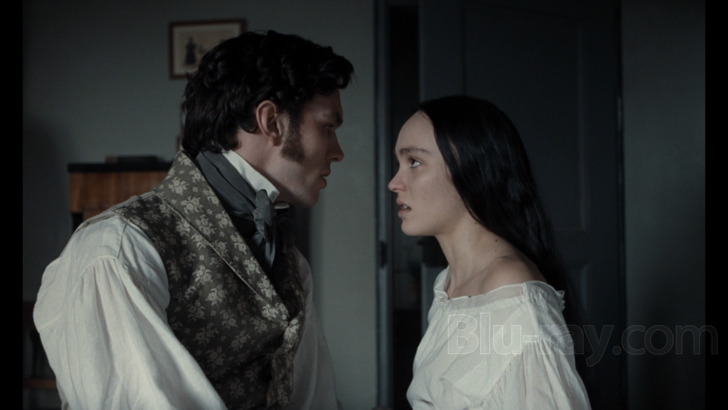
Shot on film by Cinematographer Jarin Blaschke (The Witch (2015)), Nosferatu, his fourth teaming with Robert Eggers, looks fantastic on Blu-
ray, delivering impeccable fine detail alongside an organic and light grain structure. For the film, he used ARRICAM ST cameras with a mix of vintage
and modern lenses. Blaschke also opted to stick to the same film stock across all shots, regardless of location, lighting, or time of day, to provide the
film with a consistent look, feel, and identity. Recalling its silent film origins, just as that film was incredibly dark, this modern retelling of Nosferatu
aims for the same look. People, locations, and set elements are often bathed in shadow, creating a sense of unease as the viewer is increasingly aware
that critical information is being purposefully obscured, as Nosferatu is enabled to mask his features, his presence, and his movements. While the film is
shot in color, viewers will instantly notice that the colors are intentionally desaturated with a definite cold blue push, making the film appear, at times,
as anemic Nosferatu himself, and again, connecting this new work with the tinted nature of the original.
When watching the 1080p presentation, viewers will notice that fine detail is typically very high, allowing them to parse out particulars in faces, set
elements, and the various environments of the film. Even the old
papers in Herr Knock's cluttered office present with satisfying tactile realism. Costuming is also a highlight, whether it be the lacey trim on Emma's
clothes, the silky sheen of the young girls' dresses, or the rough and chunky texture of Count Orlok's garments. Depth and dimensionality is pleasing
and is enhanced by the deep blacks that are present in so many shots. If there is a deficit to the video presentation, though, the overwhelming
darkness is it. At times, that pervasive absence of light allows for some details to be lost in the murky shadows that dominate the picture. Take, for
instance, the moment at the film's start when Lily-Rose Depp stands in front of her ancestral home. Windows, masonry, and landscaping features
become suggestions rather than being precisely defined. Other such instances are observable as well. But for a film that is as intentionally dark as
Nosferatu (2024), it is more of a note rather than a condemnation and should be taken as such. It's a deliciously moody and absorbing transfer.
Nosferatu Blu-ray Movie, Audio Quality 
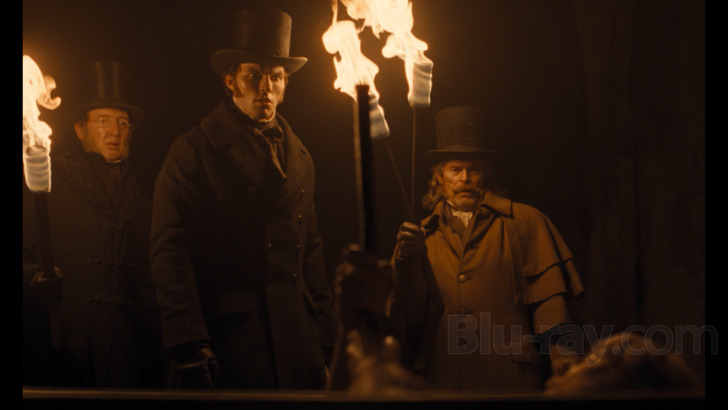
Right from the film's start, the Dolby Atmos track that accompanies Nosferatu 4K endeavours to inform viewers that it means business. Bass is deep and extremely powerful without ever being too overwhelming or impossibly heavy-handed, adding considerable depth, and most importantly, menace, to the proceedings putting viewers immediately on edge and building an atmosphere of dread even before the film's title card appears. Deeply immersive from that first scene, Count Orlok's voice and other sounds swirl through the sound stage, putting viewers perfectly in the middle of Lilly-Rose Depp's (Emma Hutter) haunting and terrifying dream/prayer. To her, it is an ill omen, a sign of impending danger, and/or ruin for her and her new husband, Thomas (Nicholas Hoult). For the viewer, it's quite the opposite, a portent of nothing but one sonic thrill after another. Some of my favorite audio moments are aboard the ill-fated Empusa that carries out the unfortunate task of delivering Count Orlok to Germany. The viewer sonically feels the relentlessly crashing waves, each countless wind-driven drop of ran, and every groaning and creaking plank of the doomed vessel. Finesse is demonstrated with the delicate skittering of a plague of rats that disembarks from the "Empusa" and moves into the fictional German town of Wisberg. Their skittering feet encircle the viewer as they make their way through the city's cobblestone streets. Directionality is superb, as sounds move realistically through the sound stage. Dialogue is cleanly rendered and music is handled exceptionally well. It's a fantastically engaging and absorbing track.
Nosferatu Blu-ray Movie, Special Features and Extras 
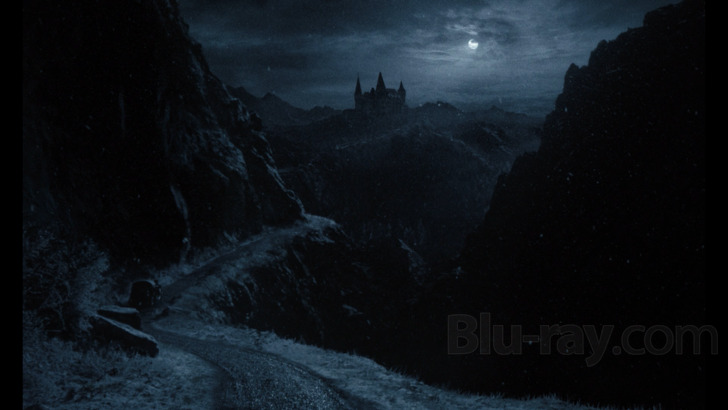
Nosferatu's on-disc supplemental material is as follows:
- Deleted Scenes
- Ellen at the Window (2.06)
- Harding's Bedchamber/Dark Corridor (2.38)
- Behold, the Third Night (1.06)
- Nosferatu: A Modern Masterpiece
- Breathing Life Into a Dream (9.26) - The cast works to make Director Robert Eggers' lifelong dream a reality.
- Becoming Count Orlok (6.12) - The creation of the titular villain is discussed.
- Capturing the Mood (5.19) - This segment covers using light, shadow, and the camera to create the film's atmosphere.
- Recreating 1838 (6.29) - Production Designer Craig Lathrop provides a look at the film's sets.
- Dressing the Part (5.55) - This feature covers the character's costumes.
- The End is Just the Beginning (7.18) - Visual effects supervisor Angela Barson and composer Robin Carolan discuss the impact of the VFX and the score.
- Feature Commentary with Writer/Director Robert Eggers - Eggers is endlessly informative throughout the duration of the commentary. It's almost a certainty that he is operating without scripted thoughts, instead relying on each particular scene to drive his anecdotes and recollections. No subject is off limits, and his deep knowledge of the project spills out across a host of topics from set design to costuming, and casting to location scouting. Among the interesting things he shares, Eggers discusses how they ended up using Pernštejn Castle in the Czech Republic for the castle exteriors which, incidentally, was the same castle used by Werner Herzog for his film Nosferatu the Vampyre (1979). Eggers' team, however, constructed a more impressive and imposing gate and tried to use different locations around the castle to keep it from being recognized by those familiar with the earlier film. It's a fascinating listen.
Nosferatu Blu-ray Movie, Overall Score and Recommendation 
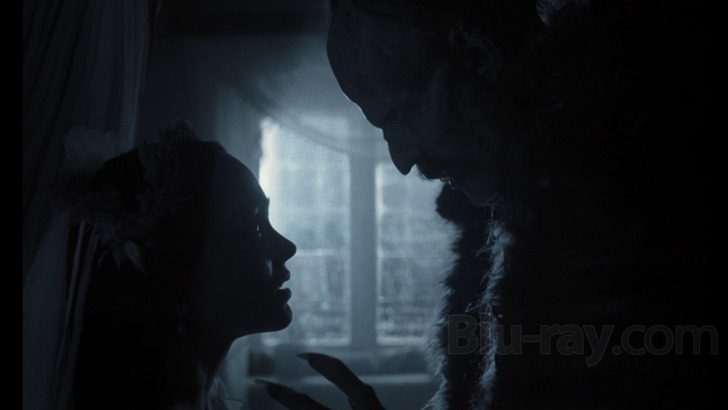
While I hesitate to get carried away with hyperbole and superlatives, Robert Eggers'Nosferatu can certainly be looked at as an example to which creators of modern horror should aspire. The film excels at constructing an atmosphere of dread, is populated by interesting, believable, and engaging characters, makes efficient and artful use of locations, and unleashes the monster only when it makes sense. All of these elements work in a coordinated fashion toward the same end. Terror. Depp, Hoult, and Dafoe each turn in layered and compelling performances while Bill Skarsgård's Nosferatu is the stuff sleepless nights are made of. The extended cut adds a mere four minutes to the film's runtime, and while not crucial the new moments do add some additional context, characterization, and threat to the tale, and it will be my choice for each subsequent viewing of the film. Beautifully shot on film and outfitted with one of the best Dolby Atmos tracks I've heard in quite some time, Nosferatu is a veritable feast for the eyes and ears. For film fans and especially horror aficionados it earns my highest recommendation.

















